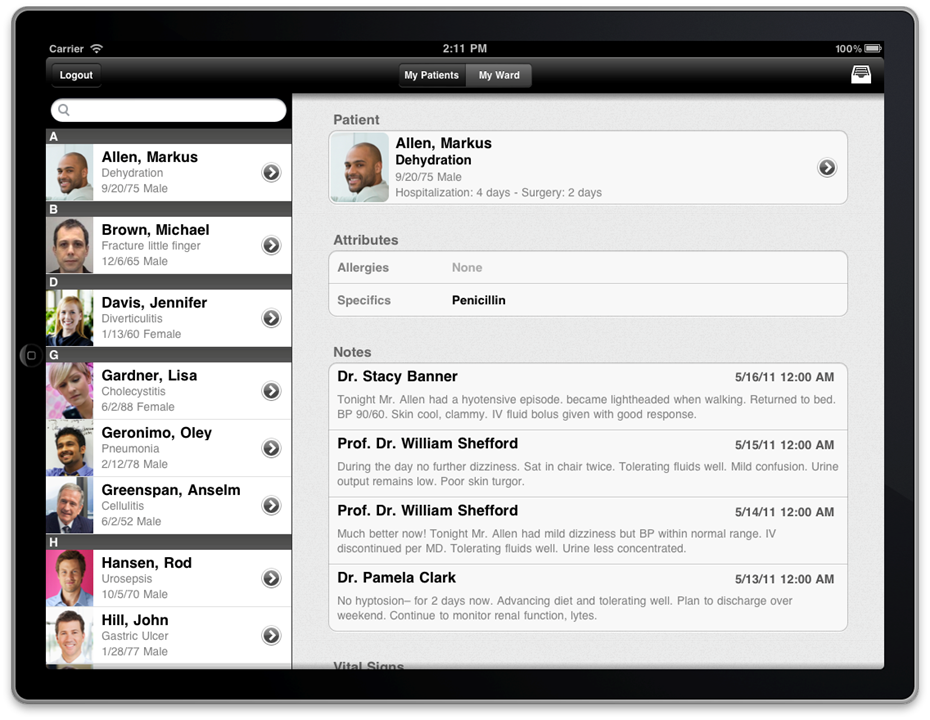How Two SAP Mobile Health Apps Can Improve Patient Care (mHealth)
Healthcare is one of the industries where mobility is making the biggest impact (insurance, financial services and education are some of the others). And I'm not just talking about Big Pharma and medical vendors arming their salespeople with tablets.
Though that certainly has happened. Vendors that have deployed hundreds or thousands of iPads installed with marketing and CRM apps to the field include Medtronic, Abbott Laboratories, Boston Scientific, Otsuka, Zimmer and Life Technologies.
But salespeople in every industry are going mobile. What's distinctive is how mobile is transforming how healthcare providers interact with patients. Within 9 months of the iPad's initial release, almost a quarter of U.S. doctors were using them. By the end of this year, about four out of ten will own them, according to another survey.
Institution-wise, Ottawa Hospital is deploying 2,300 iPads for clinical use, while Victoria Hospitals (Australia is deploying 600 iPads to its medical staff. Other adopters include Cedars-Sinai, Kaiser-Permanente, Kaweah Delta, Beth Israel Deaconess in Boston, University of Chicago Medical Center, and many others.
Much of the usage today is ad hoc: doctors can handwrite diagnostic notes or access some patient records via their tablets. Even in these limited use cases, it's proven useful.
But what if there was an app that provided a 360-degree, unified view into a patient's medical history, medications, X-rays, and vital signs? That's what SAP's coming Electronic Medical Records (EMR) app provides.
Jan Korten, a solutions manager at SAP, and Thilo Berndt, the product development manager for SAP's mobile healthcare apps, debuted the EMR app during an August 31 Webinar. You can watch the 1-hour presentation and slides here. But in the meantime, here's an illustrated summary of what they covered.
Ten SAP developers in Europe have been working on the EMR app for the past 3 months. Just finished, the app - iPad today, Android tablets like the Samsung Galaxy Tab tomorrow - is about to be piloted by a trio of European hospitals and then released at the end of October, says Korten.
Above is the central dashboard of the EMR app. From it, doctors - and, in future versions, nurses - have quick access to patient records, a list of medicines taken, pictures of X-rays, medical allergies and even a real-time view of vital signs.
There's a lot of talk about how a smooth, slick user interface is an important competitive advantage. In healthcare, however, an easy-to-use, powerful UI is mission-critical. While doctors are often very gadget-y, they are also impatient and too busy to deal with a lot of training. An intuitive UI that easily delivers the right information can actually "save lives," says Korten, a former doctor himself.
Here is the Vital Signs screen. Doctors can see which indicators are out of normal range (in red), and zoom in and out of the data. The data is sent real-time via Wi-Fi. Indeed, most of the data displayed by 1.0 version of the EMR app is streamed directly from the server, with only small amounts encrypted and cached on the iPad itself, according to Berndt.
The next version will use the Sybase Unwired Platform (SUP) middleware to store more data locally for offline access, handy when doctors are in network "dead spots" within a hospital. It will also be able to download data via 3G.
Doctors can view patient x-rays today. Future versions may let doctors take photos with the iPad and upload them to the patient records database, said Korten. Indeed, while v1.0 of the EMR app is basically read-only, future versions will be fully two-way, letting doctors (and nurses) enter diagnostic notes, capture vital sign data, and more.
Here's the high-level technical architecture: app running on multiple devices (some now, some later), multiple applications and data sources on the back-end, and the SAP Mobility Platform in the middle. This lets the devices access servers via one of three ways: SUP, SAP Gateway, and Netweaver. SAP today ties into Siemens' i.s.h. medical records platform. According to Korten, the roadmap includes the ability to tie into Picture Archiving and Communications Systems (PACS) and Lab results databases built by 3rd parties.
And here's the high-level architecture, from a business point-of-view. According to Korten, this provides business opportunities for independent developers and SAP partners: adapters that connect 3rd-party medical server applications and databases to the SAP Mobility middleware, or other mHealth apps that rely on SAP Mobility middleware to tie into multiple back-end data sources.
Even before the release of the EMR app, SAP had already developed the Collaborative eCare app. While EMR is aimed at doctors, Collaborative eCare is used by caregivers in conjunction with patients suffering chronic diseases such as diabetes or congestive health failure.
Because their diseases are often so long-lasting, patients typically must endure many appointments with their doctors to finetune their treatments. These can be lengthy and inconvenient for both parties. Calling and e-mailing their doctor or nurse can save some time, but result in patient data scattered all over the place.
With Collaborative eCare app, patients can upload data on their symptoms and medicines taken to their doctors while at home. Doctors can adjust dosages and change prescriptions and set reminders for patients to take their medicines via the app. Alerts can even be sent via text message to the patients.
Here's a video explaining more in-depth how Collaborative eCare works.
